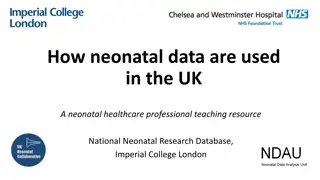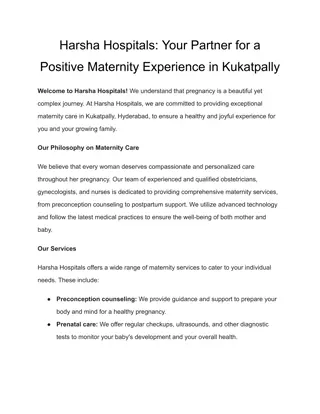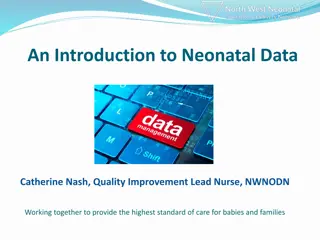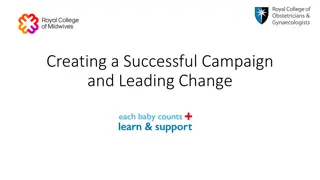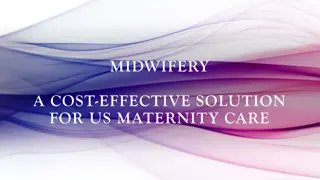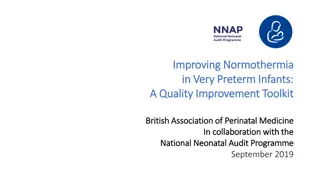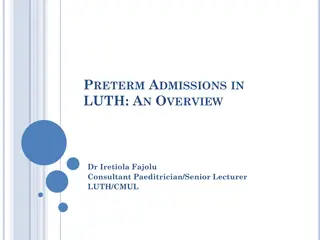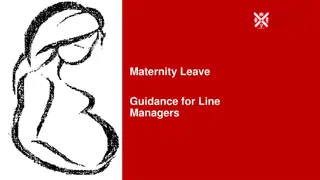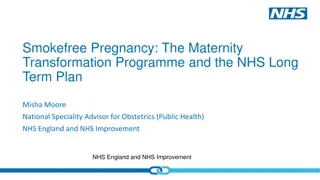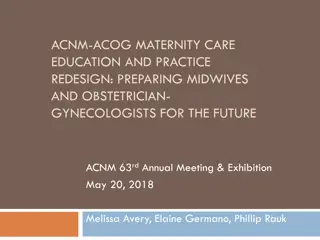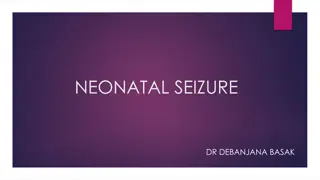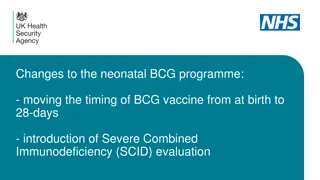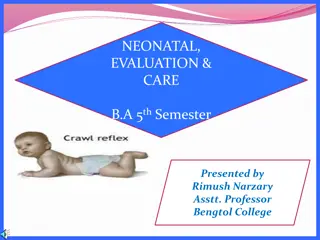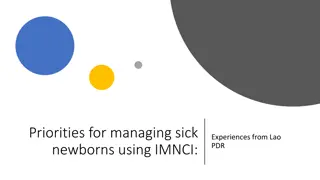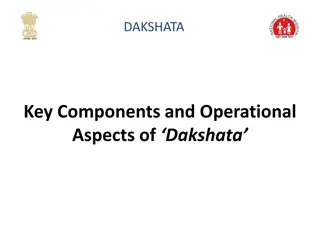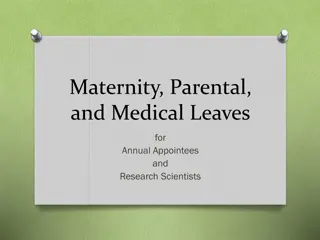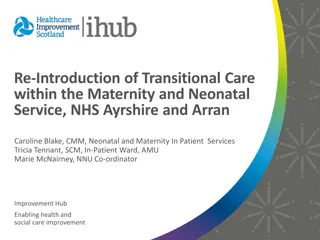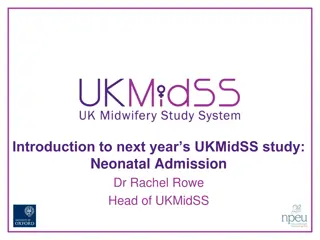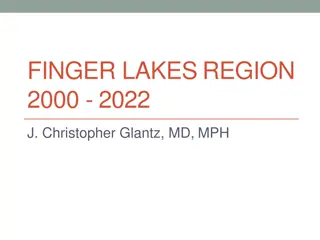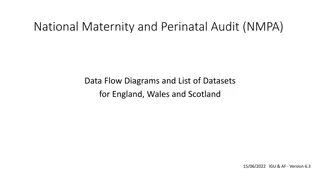Maternity and Neonatal Safety Improvement Programme Overview
The Maternity and Neonatal Safety Improvement Programme aims to enhance the quality and safety of maternity and neonatal units in England by reducing rates of maternal and neonatal deaths, stillbirths, and brain injuries. Through system-level project updates and regional collaborative efforts, the program seeks to reduce unwarranted variation and provide high-quality healthcare experiences for women, babies, and families.
Download Presentation

Please find below an Image/Link to download the presentation.
The content on the website is provided AS IS for your information and personal use only. It may not be sold, licensed, or shared on other websites without obtaining consent from the author.If you encounter any issues during the download, it is possible that the publisher has removed the file from their server.
You are allowed to download the files provided on this website for personal or commercial use, subject to the condition that they are used lawfully. All files are the property of their respective owners.
The content on the website is provided AS IS for your information and personal use only. It may not be sold, licensed, or shared on other websites without obtaining consent from the author.
E N D
Presentation Transcript
North East North Cumbria Health Safety Collaborative Learning System 2 December 2019 #MatNeoNENC #PReCePTNENC North East and North Cumbria
Welcome and introduction Julia Wood North East and North Cumbria
Overview of MatNeo SIP Patient Safety Programmes in Obstetrics Mr Kim Hinshaw CTG What we know CTG- What s next? System-level project updates Regional SCORE Update Wrap up
Maternity and Neonatal Safety Improvement Programme (previously Maternal and Neonatal Health Safety Collaborative) National Patient Safety Collaborative rebranded to become the National Patient Safety Improvement Programme All the workstreams which sit under this were also rebranded, including this programme
Maternity and Neonatal Safety Improvement Programme (previously Maternal and Neonatal Health Safety Collaborative) To support improvement in the quality and safety of maternity and neonatal units across England AIMS: Contribute to the national ambition of reducing the rates of maternal and neonatal deaths, stillbirths and brain injuries that occur during or soon after birth by 20% by 2020 To improve the safety and outcomes of maternal and neonatal care by reducing unwarranted variation and provide a high quality healthcare experience for all women, babies and families across maternity and neonatal care settings in England
Two approaches, working together Trust Improvement Learning Systems Trusts identify areas of focus which meet their needs (in line with National Driver Diagram) System improvement across North East and North Cumbria Evolve over time Building on the great work currently going on in the region
Trust Improvement: Who is involved? Wave 1 (from Apr 17) Wave 2 (from Apr 18) Wave 3 (from Apr 19) North Tees & Hartlepool NHSFT County Durham and Darlington NHSFT North Cumbria University Hospitals NHS Trust South Tees NHS FT South Tyneside and Sunderland NHSFT Usually share Trust Improvements: Gateshead Health NHS FT Only just over two months since the last event Lots to cover regarding system-level projects The Newcastle Upon Tyne Hospitals NHS FT - - Northumbria Healthcare NHS FT 44 organisations 43 organisations 46 organisations Everyone is involved in the Learning Systems
PReCePT Prevention of Cerebral Palsy in PreTerm Labour CTG Transitional Care Cardiotocography
Date for your diary 3rd March
Patient Safety Programmes in Obstetrics Mr Kim Hinshaw Director of Research, Consultant Obstetrician & Gynaecologist South Tyneside & Sunderland NHS Foundation Trust North East and North Cumbria
See Kim Hinshaws slides in the available pdf
CTG What We Know Dr Stephen Sturgiss North East and North Cumbria
Physiological CTG interpretation: what do we know Where did we get to at the end of the last meeting Enthusiasm to propose region-wide adoption of physiological interpretation Acknowledgement that such a decision needs wide-ranging agreement Critical to that decision will be a bringing together of evidence Facilitate decision-making within each provider unit, or at a bespoke meeting Also assess training and competency assessments
Physiological CTG interpretation: what we know What have we done since the last meeting Contacted clinical experts & leaders (directly or indirectly) Available literature Tele-conferences with: East of England Oxford Northern
Physiological CTG interpretation CTG features baseline heart rate Normal baseline Value between 110-160 bpm Tachycardia Baseline > 160 bpm for 10+ mins Bradycardia Baseline < 110 bpm for 10+ mins Values of of 90-110 can occur in a normal fetus, especially in a postdate pregnancy Intrapartum Fetal Monitoring Guideline February 2018. Chandraharan et al
Physiological CTG interpretation CTG features - Baseline variability (BLV) Normal: Increased BLV (saltatory): Reduced BLV: Pseudo- sinusoidal: Sinusoidal: Bandwidth amplitude 5- 25 bpm < 5 for 50+ mins or 3+ mins during decels Regular, smooth, undulating signal at 5-15 bpm + no accels 25+ for 30+ mins Resembles sinusoidal + more jagged pattern Intrapartum Fetal Monitoring Guideline February 2018. Chandraharan et al
Physiological CTG interpretation CTG features Decelerations (15+ bpm for 15+ secs) Early decelerations: Gradual (ie onset to nadir > 30 secs) + coincide with contractions Variable decelerations: V-shaped, with rapid drop (< 30 secs to nadir) + rapid recovery Prolonged deceleration Decels for 3+ mins Late decelerations Gradual onset + return, + increased or reduced variability within decel Do not indicate hypoxia Indicative of hypoxiaemia Rarely indicate hypoxia, unless evolve to U-shape + ( 60 s criteria), or reduced / increased variability during decel Likely to indicate hypoxiaemia Intrapartum Fetal Monitoring Guideline February 2018. Chandraharan et al
Physiology of hypoxia in labour Acute hypoxia Prolonged decel 5+ min (or 3+ min if reduced BLV) Causes Accidents cord prolapse, abruption, uterine rupture Iatrogenic maternal hypotension, uterine hyperstimulation Management 3-minute rule (unless preceded by reduced BLV) 3+ min raise emergency alarm 3-6 diagnosis 6-9 prepare for delivery 9-12 aim for delivery by 12-15 mins Intrapartum Fetal Monitoring Guideline February 2018. Chandraharan et al
Physiology of hypoxia in labour Subacute hypoxia Fetus spends majority of time in decels Invariably caused by hyperstimulation Management in 1st stage Stop / reduce uterotonics Avoid supine position Start IV fluids Consider tocolytics Expedite delivery if persists Management in 2nd stage Stop pushing Expedite delivery if no recovery in 10 mins Intrapartum Fetal Monitoring Guideline February 2018. Chandraharan et al
Physiology of hypoxia in labour Gradually evolving hypoxia (stages 1-4) Most common form of hypoxia in labour Stages 1-4 - represent evidence of stress + fetal compensation Stage 3 Stage 1 Stage 2 - loss of accels - lack of cycling Stage 4 - exaggerated response to hypoxia - decels wider and deeper - hypoxic stress - decels - redistribution to vital organs - facilitated by catecholamines - rise in baseline FHR Intrapartum Fetal Monitoring Guideline February 2018. Chandraharan et al
Physiology of hypoxia in labour Gradually evolving hypoxia stages 5 & 6 (fetal decompensation) Stages 4 (&5) may be reversible Stage 5 further redistribution vasoconstriction affects brain reduced BLV Stage 6 terminal heart failure unstable / progressive decline in BLR step ladder pattern to death Management improve fetal conditions with first signs of redistribution (stage 4) Intrapartum Fetal Monitoring Guideline February 2018. Chandraharan et al
Physiology of hypoxia in labour Chronic hypoxia Antenatal type of hypoxia Presents as BLR at upper end of normal, with reduced BLV + often shallow decels Indicates a fetus with reduced reserve Low threshold for surgical intervention Intrapartum Fetal Monitoring Guideline February 2018. Chandraharan et al
Physiological interpretation of CTGs Management of suspected fetal hypoxia Hypoxia Features Management Gradually Evolving hypoxia Compensated Likely to respond to conservative interventions (see below) Regular review every 30-60 minutes to assess for signs of further hypoxic change, and that the intervention resulted in an improvement. Other causes such as reduced placental reserve MUST be considered and addressed accordingly Rise in the baseline (with normal variability and stable baseline) preceded by decelerations and loss of accelerations Decompensated Needs urgent intervention to reverse the hypoxic insult (remove PG pessary, stop oxytocin, tocolysis) Expedite delivery if no improvement seen Reduced or increased variability Unstable/ progressive decline in the baseline (step ladder pattern to death) Intrapartum Fetal Monitoring Guideline February 2018. Chandraharan et al
Physiological interpretation of CTGs Management of suspected fetal hypoxia Hypoxia Features Management Subacute hypoxia More time spent during decelerations than at the baseline First stage Remove prostaglandins/stop oxytocin infusion If no improvement, needs urgent tocolysis If still no evidence of improvement within 10-15 minutes, review situation and expedite delivery May be associated with saltatory pattern (increased variability) Second stage Stop maternal active pushing during contractions until improvement is noted. If no improvement is noted, consider tocolysis if delivery is not imminent or expedite delivery by operative vaginal delivery Intrapartum Fetal Monitoring Guideline February 2018. Chandraharan et al
Physiological CTG interpretation: Significance of baseline FHR after onset of decelerations Without tachycardia (n=81) With tachycardia (N=262) Z P-value Gestational age (weeks) 40.4 40.3 -0.868 .386 Birthweight (g) 3371 3427 1.157 .247 1 min Apgar 8.82 +/- 1.0 7.96 +/- 1.78 -4.816 0.000 5 min Apgar 9.79 +/- 0.47 9.34 +/- 1.04 -4.03 0.000 Umbilical arterial pH 7.25 +/- 0.05 7.20 +/- 0.1 -3.38 0.001 < 7 0 13 (5%) 2.927 0.087 > 7 81 249 (95%) Jia et al (2019) J Maternal-Fetal & Neonatal Medicine
Types of intrapartum hypoxia on the CTG: do they have any relationship Types of intrapartum hypoxia on the CTG: do they have any relationship with the type of brain injury in the MRI scan in term babies with the type of brain injury in the MRI scan in term babies Primary objective Examine whether an interpretation of CTGs using types of intrapartum hypoxia correlates with the nature of hypoxic injuries Retrospective study of 52,187 births at St George s (2006-17) 16 babies with postnatal diagnosis of HIE AAP criteria from 2003 used to diagnose occurrence of acute hypoxic event CTG traces classified independently by 2 assessors (SSY/EC) Yatham+ J Obstet Gynecol https://doi.org/10.1080/01443615.2019.1652576
Types of intrapartum hypoxia on the CTG: do they have any relationship Types of intrapartum hypoxia on the CTG: do they have any relationship with the type of brain injury in the MRI scan in term babies with the type of brain injury in the MRI scan in term babies 52,187 births between 2006 and 2017 16 cases of HIE (0.3 / 1000) (cf ) Condition Year 2012 2013 2014 2015 HIE No.of cases 1674 1674 1824 1742 Rate / 1000 LBs 2.4 2.5 2.8 2.6 Number of term cases 1409 1401 1480 1417 Number of term births 640787 612816 607972 609076 Rate term cases 2.2 2.2 2.4 2.3 Gale et al 2017 ArchDis Child Fetal Neonatal Ed Yatham+ J Obstet Gynecol https://doi.org/10.1080/01443615.2019.1652576
Types of Types of intrapartum intrapartum hypoxia on the CTG: do they have any relationship hypoxia on the CTG: do they have any relationship with the type of brain injury in the MRI scan in term babies with the type of brain injury in the MRI scan in term babies 52,187 births between 2006 and 2017 16 cases of HIE (0.3 / 1000) (cf national of 1.4-1.8 / 1000) Other quoted outcomes Intrapartum emergency CS: Emergency CS for failed instrumental: Intrapartum stillbirths: 8.1% 0.3-0.5% None in 7+ yrs Yatham+ J Obstet Gynecol https://doi.org/10.1080/01443615.2019.1652576
Types of intrapartum hypoxia on the CTG: do they have any relationship Types of intrapartum hypoxia on the CTG: do they have any relationship with the type of brain injury in the MRI scan in term babies with the type of brain injury in the MRI scan in term babies Our study has shown that, whilst our rate of HIE based on Sarnat Criteria is 0.8/1000, our actual rate of neurological damage based on neonatal MRI scan is much lower (16/52,187 births or 0.3/1000). Yatham+ J Obstet Gynecol https://doi.org/10.1080/01443615.2019.1652576
Types of intrapartum hypoxia on the CTG: do they have any relationship Types of intrapartum hypoxia on the CTG: do they have any relationship with the type of brain injury in the MRI scan in term babies with the type of brain injury in the MRI scan in term babies Inter-observer agreement: 81% Typical reported rates: 30% (Rhose et al, 2014. Reif et al, 2016. Hruban et al, 2016) Yatham+ J Obstet Gynecol https://doi.org/10.1080/01443615.2019.1652576
Types of intrapartum hypoxia on the CTG: do they have any relationship Types of intrapartum hypoxia on the CTG: do they have any relationship with the type of brain injury in the MRI scan in term babies with the type of brain injury in the MRI scan in term babies Hypoxia No. of babies MRI findings Subacute 3 Normal (1), Unavailable (2) Evolving 4 Normal (1). Abnormalities in thalami (1), diffuse cortical injury (2) Combined acute + subacute 2 Abnormal myelination in ares supplied by posterior circulation (1), Unavailable (1) Combined evolving + acute 2 Abnormal myelination in areas supplied by post circulation + very severe HIE (1), Unavailable (1) Evolving + subacute 2 Normal (1), Severe atrophy of cerebral hemisphere in watershed areas None 3 Post cerebral infarct (1), Metabolic pathology (1) Yatham+ J Obstet Gynecol https://doi.org/10.1080/01443615.2019.1652576
Improvements in Intrapartum Caesarean Sections, FBS Rates & HIE Rates after Physiology-based CTG Masterclasses 120 100 80 60 40 20 0 St George's Poole Oman South Newport Peterborough Limerick Warwickshire % Reduction in FBS
Physiologic interpretation of CTGs Case study from Lewisham & Greenwich NHS Trust Sign up to Safety team introduced physiologic interpretation Staff attended CTG masterclass Weekly CTG meetings, induction program and mandatory training Appointment of B7 midwives 32% reduction in number of babies admitted to NICU with HIE Reduction in babies transferred out for cooling ( Only a couple of FBSs )
Evaluating the value of intrapartum FBS to predict adverse neonatal outcomes: A UK multicentre observational study Outcome Test threshold Sensitivity Specificity Positive predictive value Negative predictive value Area under the curve (95%CI, p value) Neonatal acidaemia Suboptimal pH 22 87.3 4.9 97.4 0.59 (0.51-0.68, 0.31) Abnormal pH 7.3 94.6 3.9 97.2 Apgar < 7 at 1 min Suboptimal pH 14.5 87.5 23.4 79.6 0.55 (0.51-0.59, 0.004) Abnormal pH 8.8 95.5 33.8 79.9 Apgar < 7 at 5 mins Suboptimal pH 20.3 87.4 7.6 95.6 0.55 (0.48-0.62, 0.13) Abnormal pH 7.2 94.7 6.5 95.2 NICU admission Suboptimal pH 20.3 78.5 13.3 92.1 0.58 (0.52-0.53, 0.0002) Abnormal pH 9.3 94.7 14.3 91.8 Wattar et al 2019 Eur J Obstet Reprod Biology
Physiological interpretation of CTGs What do we know? Some evidence of reduction in HIE Underlying principles not rebutted by neuro-anatomic evidence No evidence of increase in interventions (and potentially a reduction) Recent evidence in relation to merit of FBS is equivocal Very strong case for formal evaluation Enthusiasm ++++
CTG Whats next Facilitated by Dr Stephen Sturgiss and Julia Wood
CTG Whats next?: Part 1 Group Work Focus on three areas, identified through the table discussions at the LLS in September: Training and competence assessments (tables 1 and 2) Ensuring staff implementation (tables 3 and 4) Resistance to change how to overcome it (tables 5 and 6) Two tables focus on each area If you want to move tables, please move now
Use of the Kipling Questions: Barriers What: What are the potential barriers? Where: Where will be the barrier/s? (so in which part of the process/system)? Who: Who may be the barrier? When: At which point in the process/system will the potential barrier/s become evident? I keep six honest serving men (They taught me all I knew); Their names are What and Why and When And How and Where and Who Why: Why is each barrier a problem? How: How will we know that the potential barrier has become a problem? 20 minutes
Use of the Kipling Questions: Overcoming Barriers What/Where/Why: You have this information from the previous group work How: How should each barrier be tackled When: When is the best time to tackle each barrier? Who: Who is best placed to tackle the each barrier? (individual/staff group/organisation) 20 minutes
Refreshment Break #MatNeoNENC #PReCePTNENC North East and North Cumbria
CTG - Whats next?: Part 2 Feedback from each table (20 minutes in total)
System-level Projects System-level Projects Updates Dr Sundeep Harigopal Martyn Boyd Karen Hooper North East and North Cumbria
TC at the RVI Dr Sundeep Harigopal Dec 2019
Location Predominantly on one of two PNW Nursery nurse focus and TC nursing base Overflow capacity possible on other PNW No theoretical cot limit to TC number on any day
How Mother with baby always (Dad alone tricky) PNW run jointly by midwives and TC with nursery nurses Baby care delivered by all of TC, nursery nurses and midwives Oversight by consultant Daily ward round on TC (M-F) w/e trouble shooting
When 24/7 and 365 on level of mother with baby and care delivery unchanged Deliverers of care do change TC M-F 07:30 15:30, junior docs OOH W/e some TC, more junior docs off NICU Consultant availability always dedicated M-F, shared with NICU, transport OOH
What i.v antibiotics NG feeds Heated cots Phototherapy NAS management Fresh off NICU (big babies and graduating older prems both accepted back) other (occasional stoma, complex baby etc) NIPE for TC babies, and some failsafe for NIPE TC team also do BCG s (but not viewed as TC activity)
Recording/reporting TC coded by coders for financial purposes We think by specific activity not as TC E.g phototherapy, i.v s etc No current record in badger for TC babies ?we might start
How much April 356 days May -369 June 345






